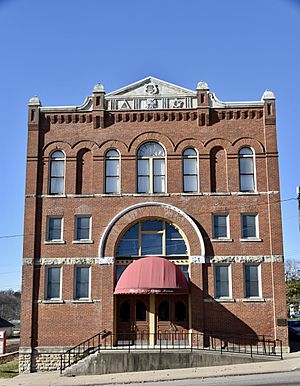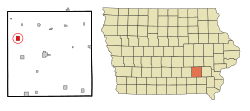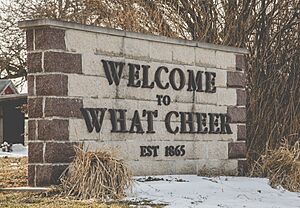What Cheer, Iowa facts for kids
Quick facts for kids
What Cheer, Iowa
|
|
|---|---|

What Cheer Opera House
|
|

Location of What Cheer, Iowa
|
|
| Country | |
| State | |
| County | Keokuk |
| Area | |
| • Total | 1.26 sq mi (3.25 km2) |
| • Land | 1.24 sq mi (3.20 km2) |
| • Water | 0.02 sq mi (0.05 km2) |
| Elevation | 751 ft (229 m) |
| Population
(2020)
|
|
| • Total | 607 |
| • Density | 490.70/sq mi (189.43/km2) |
| Time zone | UTC-6 (Central (CST)) |
| • Summer (DST) | UTC-5 (CDT) |
| ZIP Code |
50268
|
| Area code(s) | 641 |
| FIPS code | 19-84900 |
| GNIS feature ID | 2397291 |
What Cheer is a small city in Keokuk County, Iowa, United States. It used to be a very important coal town. From the 1870s to the early 1900s, it was one of Iowa's main places for producing coal. At its busiest, in 1890, the city had 3,246 people. By the 2020 census, the population was 607.
Contents
How What Cheer Got Its Name
What Cheer was first started in 1865. It was called Petersburg, named after its founder, Peter Britton. But the Post Office didn't like this name. So, the town had to pick a new one.
Joseph Andrews, a major who fought in the American Civil War, suggested the name "What Cheer." The town officially changed its name on December 1, 1879.
People have different ideas about why "What Cheer" was chosen. The phrase "what cheer with you" is an old English greeting. It has been used since at least the 1400s. One idea is that a Scottish miner shouted "What cheer!" when he found a coal seam near the town.
Another story says that Joseph Andrews chose the name because of a famous greeting from his hometown, Providence, Rhode Island. The story goes that when Roger Williams arrived in Providence in 1636, Native Americans greeted him with "What Cheer, Netop." Netop meant friend in their language. The Narragansetts had learned "what cheer" from English settlers. It's also possible the name was just a coincidence.
What Cheer is often listed as one of the most unusual place names in the world.
History of What Cheer
A man named Robert Forsyth came to America in 1857 from Scotland. He worked as a coal miner for about ten years. Then he came to Petersburg, which later became What Cheer. In the 1870s, he started buying land with coal on it. He often bought it using credit, meaning he promised to pay later.
When the railroad came to town, he rented his land to coal companies. He also bought a share in a local drug store. Other Scottish people also moved to the area to work in the mines.
The Railroad and Coal Mining Boom
The Burlington, Cedar Rapids and Northern Railway (BCR&N) built a 66-mile long train track to What Cheer in 1879. When the railroad arrived, the What Cheer coalfield quickly became very important. It was one of the biggest coal mining areas in Iowa.
For example, the Starr Coal Company had over 200 workers. They could dig up 1,000 tons of coal every day. By 1883, they ran three mines and took over several others. In 1884, another railroad, the Chicago and North Western Railway, also built a line through What Cheer. This led to even more mining in the area.
Miners' Strikes and Unions
Workers in What Cheer formed groups to ask for better pay and conditions. One group, Local Assembly 1474 of the Knights of Labor, had 65 members in 1884.
On October 15, 1884, 500 miners in What Cheer went on strike. They stopped working to demand higher wages. They wanted half a cent more per bushel of coal. The state military was ready, but after six weeks, the miners agreed to a quarter-cent raise. This strike greatly reduced coal production in What Cheer.
In 1891, miners in What Cheer and other towns went on strike again. They wanted an eight-hour day, meaning they would only work eight hours a day. About 1,000 men in What Cheer stopped working. But they went back to work on June 16 without getting the eight-hour day.
Later, in 1896, miners struck again over other issues. This strike lasted about 10 to 12 weeks. A union called Local 841 of the United Mine Workers was formed in What Cheer in 1897. By 1902, it had 200 members.
Local Industries and Decline
The first factories in What Cheer were built to help the coal mines. In 1890, three companies in What Cheer made mining drills. One of these, the What Cheer Drill Company, later sold equipment all over the country.
By 1909, only a few mines were left in the county. They mostly produced coal for local use in What Cheer. As the mines declined in the 1900s, fewer people joined the miners' union. By 1912, the local union had only 18 members.
The What Cheer Clay Products Company also dug up coal. But for them, coal was a side product. Their main goal was to get the clay found under the coal. This company started in 1911.
Geography
Most of What Cheer is located on the northeast side of Coal Creek. This creek flows into the North fork of the Skunk River.
The city covers about 1.24 square miles (3.2 square kilometers). Most of this area is land, with a small amount of water.
Transportation
Iowa Highway 21 goes through What Cheer, running north and south. The edge of the city to the northwest is near G29 Road.
Population Changes
| Historical populations | ||
|---|---|---|
| Year | Pop. | ±% |
| 1880 | 719 | — |
| 1890 | 3,246 | +351.5% |
| 1900 | 2,746 | −15.4% |
| 1910 | 1,720 | −37.4% |
| 1920 | 1,626 | −5.5% |
| 1930 | 1,310 | −19.4% |
| 1940 | 1,339 | +2.2% |
| 1950 | 1,119 | −16.4% |
| 1960 | 956 | −14.6% |
| 1970 | 868 | −9.2% |
| 1980 | 803 | −7.5% |
| 1990 | 762 | −5.1% |
| 2000 | 678 | −11.0% |
| 2010 | 646 | −4.7% |
| 2020 | 607 | −6.0% |
| Iowa Data Center Source: |
||
What Cheer in 2020
In 2020, there were 607 people living in What Cheer. There were 264 households in the city. About 25% of households had children under 18 living there. The average age of people in What Cheer was 43 years old. About 27% of residents were under 20 years old.
What Cheer in 2010
In 2010, the city had 646 people. There were 293 households. The average age was 45.3 years. About 23% of residents were under 18 years old.
Education
The Tri-County Community School District runs the public schools in the area.
Famous People From What Cheer
- Betty De Boef: An Iowa State Representative who lives in What Cheer.
- Frank Hayes: He was the president of the United Mine Workers union from 1917 to 1920. He was born in What Cheer in 1882.
- B. J. Palmer: He helped develop chiropractic medicine. He was also born in What Cheer in 1882.
- Ed Thomas: He grew up in What Cheer. He was named the NFL high school football coach of the year in 2005.
What Cheer in Stories
What Cheer is the hometown of the main character in a long novel called Miss MacIntosh, My Darling (1965) by Marguerite Young. The author said in 1993 that she didn't know What Cheer was a real place!
What Cheer is also where the novel "The Home For Wayward Clocks" is set. This book was written by Kathie Giorgio and published in 2011.
See also
 In Spanish: What Cheer (Iowa) para niños
In Spanish: What Cheer (Iowa) para niños



